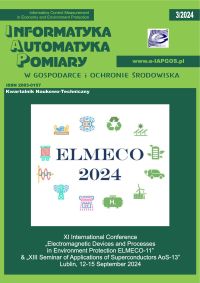SYSTEMY FOTOWOLTAICZNE W BUDYNKACH – MODEL PRACY W WARUNKACH KLIMATYCZNYCH LUBLINA A ASPEKTY ŚRODOWISKOWE
Agnieszka Żelazna
a.zelazna@wis.pol.lublin.plPolitechnika Lubelska, Wydział Inżynierii Środowiska, Instytut Inżynierii Odnawialnych Źródeł Energii, Zakład Zrównoważonego Rozwoju (Polska)
Abstrakt
Z uwagi na rosnącą konsumpcję oraz wyczerpywanie złóż kopalin jednym z istotnych problemów jest zaopatrzenie w energię. W związku z tym odnawialne źródła energii, takie jak energia słoneczna, stają się coraz bardziej popularne, jednak wprowadzaniu na rynek nowych technologii powinna zawsze towarzyszyć analiza ich oddziaływania na środowisko. W niniejszym artykule przedstawiono wyniki porównania emisji ditlenku węgla na bazie metodologii zarządzania środowiskowego Life Cycle Assessment (Ocena Cyklu Życia) wybranych systemów fotowoltaicznych. Symulacja pracy instalacji obejmowała uwzględnienie lokalnych warunków klimatycznych. W porównaniu ze wskaźnikami emisji dla konwencjonalnych źródeł energii, wymienione technologie wykazują znaczny spadek wskaźników emisji gazów cieplarnianych w perspektywie cyklu życia i dlatego też mogą być stosowane w celu realizacji uregulowań międzynarodowych w tym zakresie.
Słowa kluczowe:
ślad węglowy, energia słoneczna, konwersja fotowoltaiczna, ocena cyklu życia, zarządzanie środowiskowe, wskaźnik Global Warming PotentialBibliografia
Adamczyk J.: Koncepcja zrównoważonego rozwoju w zarządzaniu przedsiębiorstwem, Wydawnictwo Akademii Ekonomicznej w Krakowie, Kraków 2006.
Google Scholar
Alsema E.A.: Energy Pay-back Time and CO2 emissions of PV systems. Progress in Photovoltaics: Research and Applications, Vol. 8, I. 1, 2000, 17-25.
Google Scholar
Ardente F., Beccali G., Cellura M., Lo Brano V.: Life cycle assessment of solar thermal collector. Renewable Energy, Vol. 30, 2005, 1031-1054.
Google Scholar
Battisti R.G, Corrado A.: Environmental assessment of solar thermal collectors with integrated water storage. Journal of Cleaner Production, Vol. 13, 2005, 1295-1300.
Google Scholar
Cel W., Pawłowski A., Cholewa T.: Ślad węglowy jako miara zrównoważoności odnawialnych źródeł energii / Carbon footprint as the sustainability indicator for renewable energy sources. Prace Komisji Ekologii i Ochrony Środowiska Bydgoskiego Towarzystwa Naukowego, Vol. IV, 2010, 15-22.
Google Scholar
Frankl P., Corrado A., Lombardelli S.: Photovoltaic (PV) systems, final report ECLIPSE. European Commission 2004.
Google Scholar
Fthenakis V.M.: Life Cycle Impact analysis of cadmium in CdTe PV production. Renevable & Sustainable Energy Review, Vol. 8, 2004, 303-334.
Google Scholar
Fthenakis V.M., Kim H.C., Alsema E.: Emissions from Photovoltaic Life Cycles. Environmental Science Technology, Vol. 42, 2008, 2168-2174.
Google Scholar
Kalogirou S.: Environmental benefits of domestic solar energy systems. Energy Conversion and Management, Vol. 45, 2004, 3075-3092.
Google Scholar
Kalogirou S.: Thermal performance, economic and environment al life cycle analysis of thermosiphon solar water heaters. Solar Energy, Vol. 83, 2009, 39-48.
Google Scholar
Kowalski Z., Kulczycka J., Góralczyk M.: Ekologiczna ocena cyklu życia procesów wytwórczych (LCA)/Ecological Life Cycle Assessment of manufacturing processes (LCA), PWN, 2007.
Google Scholar
Pawłowski A.: Rewolucja rozwoju zrównoważonego. Problemy Ekorozwoju/Problems of Sustainable Development, Vol. 4, No 1, 2009, 65-76.
Google Scholar
Popczyk J.: Ocena potencjału realizacji celów Pakietu 3x20, w szczególności w aspekcie redukcji emisji za pomocą różnych technologii. Zmiany klimatu – wyzwania dla gospodarki, Vol. 4, 2009, http://csm.org.pl/
Google Scholar
www.jrc.ec.europa.eu, Joint Research Centre, 01.2015.
Google Scholar
Zbiciński I., Staveniuter J., Kozłowska B., Van De Covering H.P.M.: Product Design and Life Cycle Assessment, Book 3 in a series on Environmental Management, The Baltic University Press, Uppsala 2006.
Google Scholar
Zdyb A.: Badania nad zwiększeniem wydajności barwnikowych ogniw słonecznych. Monografie PAN, Vol. 94, Lublin, 2012.
Google Scholar
Żelazna A., Pawłowski A.: Korzyści środowiskowe z wykorzystania systemów solarnych na przykładzie budynku jednorodzinnego, Proceedings of ECOpole, Vol. 5(2), 2011, 649.
Google Scholar
Autorzy
Agnieszka Żelaznaa.zelazna@wis.pol.lublin.pl
Politechnika Lubelska, Wydział Inżynierii Środowiska, Instytut Inżynierii Odnawialnych Źródeł Energii, Zakład Zrównoważonego Rozwoju Polska
Statystyki
Abstract views: 178PDF downloads: 68
Licencja

Utwór dostępny jest na licencji Creative Commons Uznanie autorstwa – Na tych samych warunkach 4.0 Miedzynarodowe.








